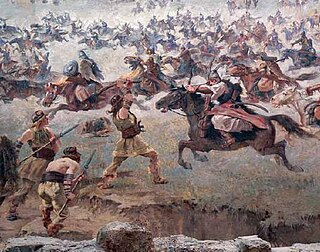 W
WWar is an intense armed conflict between states, governments, societies, or paramilitary groups such as mercenaries, insurgents, and militias. It is generally characterized by extreme violence, aggression, destruction, and mortality, using regular or irregular military forces. Warfare refers to the common activities and characteristics of types of war, or of wars in general. Total war is warfare that is not restricted to purely legitimate military targets, and can result in massive civilian or other non-combatant suffering and casualties.
 W
WChild Friendly Spaces (CFS) are safe spaces set up in emergency settings to help support and protect children. Their objective is to restore a sense of normality and continuity to children whose lives have been disrupted by war, natural disaster, or other emergencies. They provide children with opportunities to develop, play, learn, and strengthen resiliency either after a crisis or during a protracted emergency in a safe, child friendly, and stimulating environment. NGOs or governments design and operate CFS in a participatory manner, often relying on community support. They are a short- to medium-term program response and often operate in tents or temporary structures. CFS are one of the most widely used child protection and psychosocial support interventions in emergencies. One reason for their popularity is that they offer potential for adaptability of activities to diverse contexts, rapid deployment, and low relative costs. Different agencies refer to CFS by different names including Child Centered Spaces (CCS), Safe Spaces, Safe Play Areas, and Child Friendly Spaces/Environments (CFS/E).
 W
WChildhood in war refers to children who have been affected, impaired or even injured during and in the aftermath of armed conflicts. Wars affect all areas of involved persons' life, including physical and mental-emotional integrity, social relations with the family and the community, as well as housing. More often than not, these experiences affect a child's further development.
 W
WThe effects of war are widely spread and can be long term or short term. Soldiers experience war differently than civilians, although either suffer in times of war, and women and children suffer unspeakable atrocities in particular. In the past decade, up to two million of those killed in armed conflicts were children. The widespread trauma caused by these atrocities and suffering of the civilian population is another legacy of these conflicts, the following creates extensive emotional and psychological stress. Present-day internal wars generally take a larger toll on civilians than state wars. This is due to the increasing trend where combatants have made targeting civilians a strategic objective. A state conflict is an armed conflict that occurs with the use of armed force between two parties, of which one is the government of a state. "The three problems posed by intra‐state conflict are the willingness of UN members, particularly the strongest member, to intervene; the structural ability of the UN to respond; and whether the traditional principles of peacekeeping should be applied to intra‐state conflict". Effects of war also include mass destruction of cities and have long lasting effects on a country's economy. Armed conflict has important indirect negative consequences on infrastructure, public health provision, and social order. These indirect consequences are often overlooked and unappreciated.
 W
WThe Japan–North Korea Pyongyang Declaration was signed in 2002, and was the result of a systematic Japan–North Korea summit meeting. The aim of the declaration was to provide low-interest long term loans to North Korea as well as economic assistance, including humanitarian aid, in accordance with the moratorium of nuclear missile development which has been in place since 1999. The Japanese government hoped to learn the fate of Japanese citizens by North Korea which, prior to the declaration, was unacknowledged.
 W
WThe male warrior hypothesis (MWH) is an evolutionary psychology hypothesis by Professor Mark van Vugt which argues that human psychology has been shaped by between-group competition and conflict. Specifically, the evolutionary history of coalitional aggression between groups of men may have resulted in sex-specific differences in the way outgroups are perceived, creating ingroup vs. outgroup tendencies that are still observable today.
 W
WSi vis pacem, para bellum is a Latin adage translated as "If you want peace, prepare for war".
 W
WWar pensions are almost certainly the most ancient type of social security. Plutarch's Life of Solon mentions a law which provides that those who are maimed in war shall be maintained at the public charge. Halsbury's Laws of England traced their history back to the days of King Alfred. Until 1978 the British War Pension scheme was run entirely under the Royal Prerogative and completely without legislation.
 W
WWorld War II or the Second World War, often abbreviated as WWII or WW2, was a global war that lasted from 1939 to 1945. It involved the vast majority of the world's countries—including all the great powers—forming two opposing military alliances: the Allies and the Axis. In a state of total war, directly involving more than 100 million personnel from more than 30 countries, the major participants threw their entire economic, industrial, and scientific capabilities behind the war effort, blurring the distinction between civilian and military resources. World War II was the deadliest conflict in human history, resulting in 70 to 85 million fatalities, with more civilians than military personnel killed. Tens of millions of people died due to genocides, premeditated death from starvation, massacres, and disease. Aircraft played a major role in the conflict, including in strategic bombing of population centres, the development of nuclear weapons, and the only two uses of such in war.
 W
WWorld War III and the Third World War are names given to a hypothetical third worldwide large-scale military conflict subsequent to World War I and II. The term has been in use since at least as early as 1941. Some have applied it loosely to refer to limited or smaller conflicts such as the Cold War or the War on Terror, while others assumed that such a conflict would surpass prior world wars both in its scope and in its destructive impact.